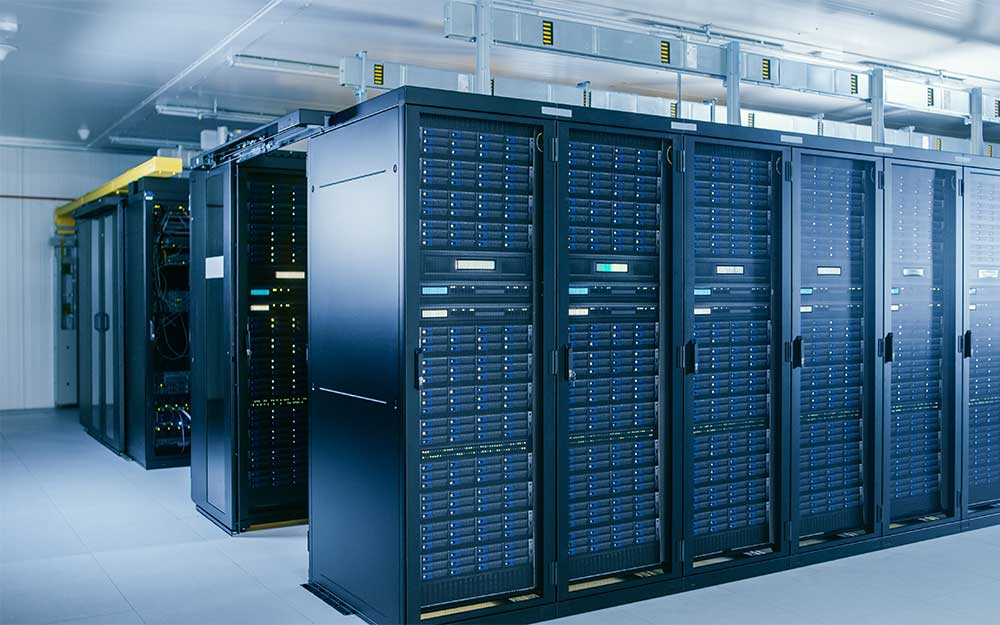
A data center is a facility used to house computer systems and associated components, such as telecommunications and storage systems. It generally includes redundant or backup power supplies, redundant data communications connections, environmental controls (e.g., air conditioning, fire suppression), and various security devices. Data centers are used by organizations to store, process, and manage large amounts of data.
Data centers can generate a significant amount of heat due to the high-density computing equipment they contain. This is because the servers, storage devices, and networking equipment in a data center are constantly running and generating heat.
Delta T Systems chillers are uniquely designed to maintain the desired operating temperature for any equipment in a data center:
- Highly energy efficient using variable speed compressors and fans.
- Cooling load leveling between 10% and 100% of capacity.
- Dew point control to prevent any form of condensation.
- Temperature control accuracy of +/- 1° Fahrenheit.
- Remote monitoring with DTS Smart Connect™.
- Chillers are equipped with a pump and tank to eliminate costly external pump tank systems.
- Modular design with the possibility to add chilling capacity later.
- Free cooling systems to use the outside air for energy efficiency.
Below are the technical details explained
To prevent overheating, data centers require sophisticated cooling systems to maintain an optimal operating temperature. These cooling systems can include air conditioning units, computer room air handlers, and even liquid cooling systems. The cooling system is designed to ensure that the temperature and humidity levels remain within a certain range to prevent damage to the equipment and to maintain reliable operation.
It’s worth noting that cooling can account for a significant portion of a data center’s overall energy consumption. For this reason, many data center operators are exploring more energy-efficient cooling solutions, such as using outside air to cool the equipment when ambient temperatures are low enough.
Using outside air for cooling, also known as free cooling or air-side economization, is a method of cooling data centers that takes advantage of cooler outdoor temperatures to reduce the need for mechanical cooling systems.
The basic idea is to bring cool outdoor air into the data center and use it to cool the equipment, rather than relying solely on air conditioning or other mechanical cooling systems. This can significantly reduce the amount of energy needed to cool the data center, which in turn can lower operating costs and reduce carbon emissions.
There are several types of liquid cooling systems that are used in data centers, including:
Direct-to-chip liquid cooling: This involves circulating coolant directly through a server’s CPU and memory modules to remove heat at the source.
Rack-level liquid cooling: This type of liquid cooling involves circulating coolant through a rack-mounted heat exchanger, which is then used to cool the servers in the rack.
Immersion cooling: This method involves submerging servers in a non-conductive liquid coolant, which absorbs the heat generated by the servers and then removes it through a heat exchanger. Delta T Systems does not provide immersion cooling.
In general, indirect cooling with a liquid is more energy-efficient than air conditioning in data centers. This is because liquid cooling systems can provide more efficient heat transfer than air cooling systems, which reduces the amount of energy required to remove heat from the data center.
With indirect liquid cooling, the outside air is used to cool a liquid coolant, which is then circulated through a heat exchanger to remove heat from the data center. This process can be more efficient than air conditioning because the liquid coolant can absorb more heat than air and can be circulated more efficiently through the data center equipment.
Additionally, liquid cooling systems can enable higher-density computing, which means that more computing power can be packed into a smaller footprint, which can further increase energy efficiency by reducing the overall energy required to power and cool the equipment.
The heat load in a data center can vary over time, depending on factors such as the workload demand, the number and type of servers in use, and the environmental conditions both inside and outside the data center.
Environmental factors can also affect the heat load in a data center. For example, outdoor temperatures and humidity levels can impact the efficiency of cooling systems and affect the overall heat load in the data center. Other factors such as equipment failure or changes in the IT infrastructure can also impact the heat load over time.
In general, liquid cooling systems should be able to maintain a temperature variation of no more than 2-3 degrees Fahrenheit (1-1.5 degrees Celsius) across the data center. This means that the temperature of the liquid coolant should be consistent throughout the system, and any variations should be minimized to ensure optimal performance and reliability of the IT equipment.
To achieve this level of accuracy, liquid cooling systems typically include sensors and controls that monitor and adjust the temperature of the coolant in real-time. These sensors and controls can adjust the flow rate of the coolant or adjust the speed of fans or pumps to maintain a consistent temperature.
